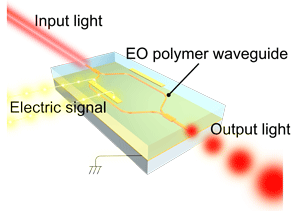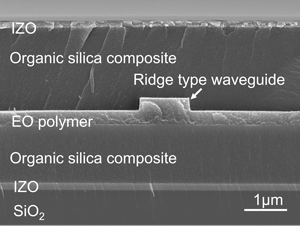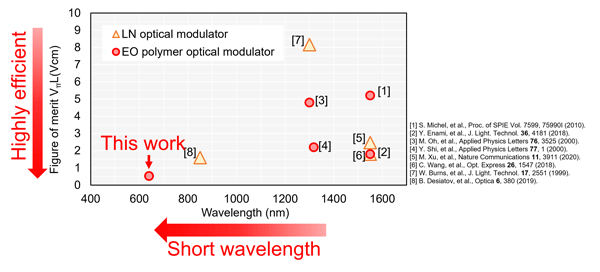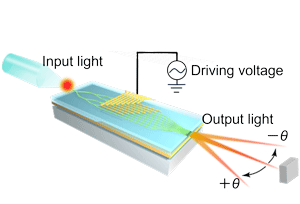Highlights
-
Development of an optical modulator using the organic electro-optic polymer operated in visible light
-
Significantly shorter wavelength and higher efficiency (smaller size and lower voltage) than conventional optical modulators for near-infrared light
-
Application to next generation display devices such as stereoscopic displays and smart glasses
Abstract
The National Institute of Information and Communications Technology (NICT, President: TOKUDA Hideyuki, Ph.D.) has successfully developed a highly efficient optical modulator using the organic electro-optic polymer (hereinafter referred to as EO polymer) for visible light. Conventional EO polymer optical modulators could operate in near-infrared light (wavelength 1,550 nm, etc.), but they couldn’t be used for visible light (wavelength 380 nm to 780 nm) because of the large absorption loss at visible light. NICT has developed an EO polymer which has small absorption loss in visible light and a large electro-optic coefficient required for the optical modulator. We fabricated an optical modulator using this EO polymer by microfabrication technology and operated the optical modulator in visible light (red, wavelength 640 nm). The demonstrated optical modulator for visible light is smaller and more efficient than the conventional EO polymer optical modulator for near-infrared light.
This EO polymer optical modulator for visible light is expected to be applied to next generation display devices such as stereoscopic displays and smart glasses.
This achievement was published in the scientific journal “Optics Express” on May 19, 2022.
Background
The growth of global internet traffic has led to the demand for optical networks with high performing technology. NICT is developing the high speeds and low driving voltages optical modulator using EO polymer more than conventional lithium niobate (LN) optical modulator. Optical modulators which convert electrical signals to optical signals are key devices for telecommunications. Compared to LN optical modulators, EO polymer optical modulators have the problem that they can only be used with near-infrared light for optical communications. The EO polymer optical modulator can be applied to scan the light beam at high speed. To use it for display devices such as stereoscopic displays, it must be available in visible light.
Achievements
In this research, we successfully developed an EO polymer which has low absorption and high electro-optic coefficient in visible light. This result was achieved by NICT's accurate measurement technology and molecular design based on the vast molecular structure library accumulated over many years. By designing the EO molecule structure to be short and rigid to suppress the absorption loss at visible light, this EO polymer has less than 1/20,000 absorption loss than conventional EO polymer and is available for visible light.
NICT designed and fabricated a Mach-Zehnder interferometer structure using microfabrication process (see Figure1). The waveguide size for operating at visible light is necessary to be small than conventional optical modulator for near-infrared light. We have adopted a ridge type waveguide (see Figure 2) which guarantees a single mode even if the width of the waveguide is relatively large. As a result, although high accuracy processing is required, the fabrication tolerance relaxed.
An electric signal was added to the developed optical modulator, and the modulation operation was evaluated. As a result, the figure of merit of optical modulators was 0.52 Vcm at a wavelength 640 nm (red color). This result is less than one-third of the traditional figure of merit which means extremely efficient (small size and low driving voltage). Furthermore, the operating wavelength is significantly shorter than before (see Figure 3).
Future Prospects
This research result of highly efficient optical modulator for visible light is pioneering achievement that bring about innovations in light beam control and display technology. The optical modulator which can control the phase of propagation light can be used for an optical phased array which is a beam steering device. The optical phased array for visible light can be available for stereoscopic displays. Compact and highly efficient display devices can be expected to be mounted in next-generation wearable terminals such as smart glasses. Furthermore, a low-cost silicon-based photodetector can be used at visible light, which leads to cost reduction of the entire system.
"I will continue to promote research and development of the optical phased array for next-generation display" said KAMADA Shun. We will also aim to develop EO polymers for green and blue other than red, and expand their applications to full color stereoscopic displays.
Reference
Title: Superiorly low half-wave voltage electro-optic polymer modulator for visible photonics
Journal: Optics Express
DOI: 10.1364/OE.456271
URL: https://doi.org/10.1364/OE.456271
Authors: Shun Kamada, Rieko Ueda, Chiyumi Yamada, Kouichi Tanaka, Toshiki Yamada, Akira Otomo
Journal: Optics Express
DOI: 10.1364/OE.456271
URL: https://doi.org/10.1364/OE.456271
Authors: Shun Kamada, Rieko Ueda, Chiyumi Yamada, Kouichi Tanaka, Toshiki Yamada, Akira Otomo





 ml.nict.go.jp
ml.nict.go.jp